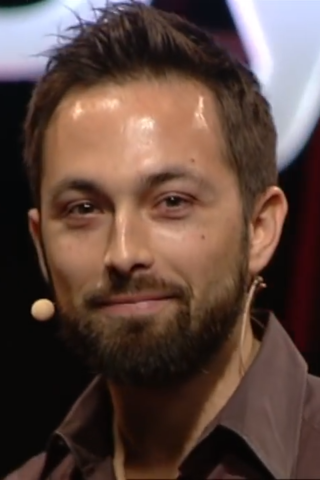Derek Muller
Science communicator (born 1982) From Wikipedia, the free encyclopedia
Derek Alexander Muller (born 9 November 1982)[3] is a science communicator and media personality, best known for his YouTube channel Veritasium, which has over 17.7 million subscribers and 3.2 billion views as of April 2025. He currently lives in Los Angeles.[4]
| Derek Muller | |||||||||||||
|---|---|---|---|---|---|---|---|---|---|---|---|---|---|
 Veritasium YouTube channel logo | |||||||||||||
 Derek Muller at TED@Sydney, 2012 | |||||||||||||
| Personal information | |||||||||||||
| Born | Derek Alexander Muller 9 November 1982 Traralgon, Victoria, Australia | ||||||||||||
| Nationality | |||||||||||||
| Other names | Veritasium | ||||||||||||
| Education |
| ||||||||||||
| Occupation | Science communicator | ||||||||||||
| Spouse | Raquel Nuno | ||||||||||||
| Website | veritasium | ||||||||||||
| YouTube information | |||||||||||||
| Channels | |||||||||||||
| Location | Los Angeles | ||||||||||||
| Years active | 2010–present | ||||||||||||
| Genre(s) | Science, education | ||||||||||||
| Subscribers |
| ||||||||||||
| Views |
| ||||||||||||
| |||||||||||||
| Television | Ancient Impossible, Catalyst, Bill Nye Saves the World, Uranium – Twisting the Dragon's Tail, Vitamania | ||||||||||||
| Awards |
| ||||||||||||
Last updated: 19 March 2024 | |||||||||||||
Early life and education
Muller was born to South African parents in Traralgon, Victoria, Australia. His family moved to Vancouver, British Columbia, Canada, when he was 18 months old.[3] In 2000, Muller graduated from West Vancouver Secondary School.[5] In 2004, Muller graduated from Queen's University in Kingston, Ontario, with a Bachelor of Applied Science in Engineering Physics.[6]
Muller moved to Australia to study film-making; however, he instead enrolled for a Ph.D. in physics education research from the University of Sydney, which he completed in 2008 with a thesis: Designing Effective Multimedia for Physics Education.[7]
Career
Summarize
Perspective
Muller has been listed as a team member of the ABC television program Catalyst since 2008.[8]
During his Ph.D. program, he taught at a tutoring company, where he became the full-time Science Head after completing his Ph.D. in 2008. He quit the job at the end of 2010.[3]
In 2011, Muller created his YouTube channel "Veritasium" (see section below), which became his main source of livelihood within a few years.[3]
Since 2011, Muller has continued to appear on Catalyst, reporting scientific stories from around the globe,[9] and on Australian television network Ten as the 'Why Guy' on the Breakfast program.[10] In May 2012, he gave a TEDxSydney talk using the subject of his thesis.[11] He presented the documentary Uranium – Twisting the Dragon's Tail, which aired in July–August 2015 on several public television stations around the world and won the Eureka Prize for Science Journalism.[12][13]
On 21 September 2015, Muller hosted the Google Science Fair Awards Celebration for that year.[14]
Muller has also won the Australian Department of Innovation Nanotechnology Film Competition and the 2013 Australian Webstream Award for "Best Educational & Lifestyle Series".[15]
Starting in April 2017, he appeared as a correspondent on the Netflix series Bill Nye Saves the World.[16]
Muller presented in film Vitamania: The Sense and Nonsense of Vitamins, a documentary by Genepool Productions, released in August 2018.[17] The film answers questions about vitamins and the use of dietary vitamin supplements.[18]
Muller's works have been featured in Scientific American,[19] Wired,[20] Gizmodo,[21] and i09.[22]
Veritasium and other YouTube channels
In January 2011, Muller created the educational science channel Veritasium on YouTube,[4] the focus of which is "addressing counter-intuitive concepts in science, usually beginning by discussing ideas with members of the public".[23] The videos range in style from interviews with experts, such as 2011 Physics Nobel Laureate Brian Schmidt,[24] to science experiments, dramatisations, songs, and – a hallmark of the channel – interviews with the public to uncover misconceptions about science. The name Veritasium is a combination of the Latin word for truth, Veritas, and the suffix common to many elements, -ium. This creates Veritasium, an "element of truth", a play on the popular phrase and a reference to chemical elements. In its logo, which has been a registered trade mark since 2016, the number "42.0" resembles an element on the periodic table.[25] The number was chosen because it is "The Answer to the Ultimate Question of Life, The Universe, and Everything" in Douglas Adams' famous novel The Hitchhiker's Guide to the Galaxy.[26]: 10m12s
In July 2012, Muller created a second YouTube channel, 2veritasium. Muller used the new platform to produce editorial videos that discuss such topics as filmmaking, showcasing behind-the-scenes footage, and for viewer reactions to popular Veritasium videos.[27]
In 2017, Muller began uploading videos on his newest channel, Sciencium, which is dedicated to videos on recent and historical discoveries in science.[28]
In 2021, Muller hosted Pindrop, a YouTube Original series exploring unusual places around the world, as seen from Google Earth. Only one episode exploring potash evaporation ponds in Utah was released before YouTube cancelled all original production in 2022.[29][30]
Reception
Veritasium videos have received critical acclaim. Two early successful Veritasium videos demonstrate the physics of a falling Slinky toy.[a] At 2012 Science Online, the video "Mission Possible: Graphene" won the Cyberscreen Science Film Festival[35] and was therefore featured on Scientific American as the video of the week.[36] A video debunking the common misconception that the moon is closer than it is, was picked up by CBS News.[37]
After a video was posted in which Muller is shown driving a wind-powered car, equipped with a huge spinning propeller, faster than the wind, UCLA physics professor Alexander Kusenko disagreed with the claim that sailing downwind faster than wind was possible within the laws of physics, and made a $10,000 bet with Muller that he could not demonstrate that the apparent greater speed was not due to other, incidental factors. Muller took up the bet, and the signing of a wager agreement by the parties was witnessed by Bill Nye and Neil deGrasse Tyson. In a subsequent video, Muller demonstrated the effect with a model cart under conditions ruling out extraneous effects, but Muller did admit he could have done a better job at explaining the phenomenon in the first video. Kusenko conceded the bet of $10,000, which was then donated to charity.[38]
Personal life and family
After Derek Muller's parents, Anthony and Shirley, married in South Africa, they moved to Vancouver, British Columbia, Canada, where his two sisters were born (Kirstie and Marilouise). The family moved to Australia, where he was born, after his father got a job in Traralgon at a pulp and paper mill. When he was 18 months old, the family moved back to Canada. Muller was educated in Vancouver and Kingston, Ontario.[3]
After Muller moved to Los Angeles, United States, he met Raquel Nuno, a planetary science Ph.D. student[39] whom he married.[3] They have four children (as of 2025).[26]
Footnotes
- The "slinky" videos explain the following: When a slinky is held dangling vertically and then released, it can be observed in slow motion that the bottom end does not begin to move until the entire slinky has collapsed, making it look as if the slinky was defying gravity (i.e., floating). This counter-intuitive phenomenon inspired a wealth of media coverage, including the Toronto Star,[31] NPR,[32] and a segment on the BBC show QI.[33] Muller also created a segment on the topic for the Australian Broadcasting Corporation show Catalyst.[34]
References
External links
Wikiwand - on
Seamless Wikipedia browsing. On steroids.
